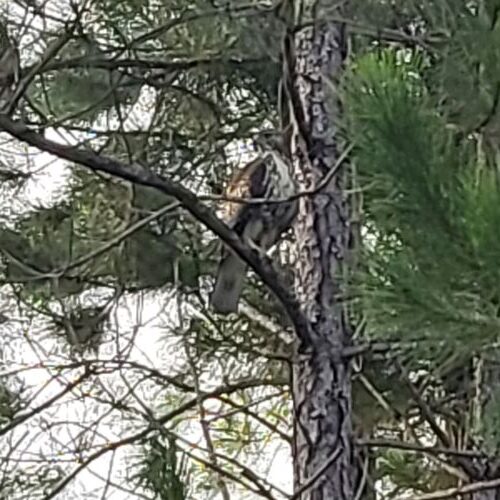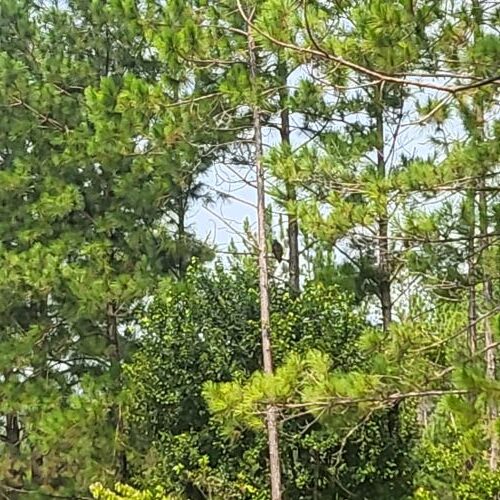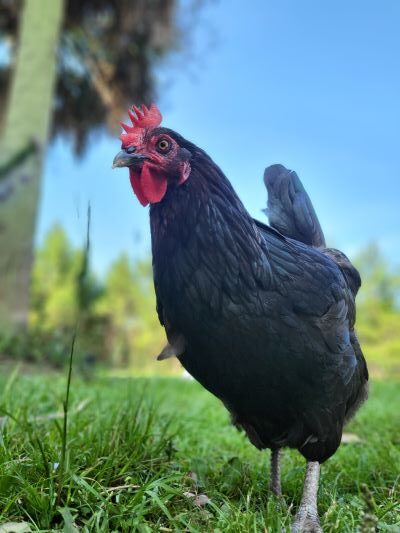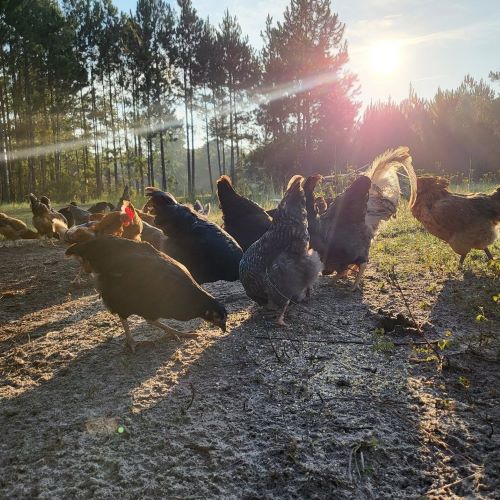Chicken’s Tale: Surviving Aerial Predators in the Free-Range Chicken Life
As we delve into my story, you’ll gain a unique perspective on the challenges we free-range chickens face and the importance of human intervention in our survival. So, join me as we navigate the joys and perils of the free-range life, and prepare to take flight into the next chapter of our tale, where the sky is not always as friendly as it seems.
The Sky is Not Always Friendly
As a chicken, the sky is a source of both wonder and worry. It’s a vast expanse of blue that promises freedom, yet it’s also the domain of our most formidable adversaries – the aerial predators. Their sudden appearance, often without warning, sends a ripple of fear through our flock. The once tranquil farmyard transforms into a scene of hurried fluttering and anxious clucking.
Our Strengths Are Our Weakness
Our natural behaviors, which are usually our strengths, unfortunately, make us appealing targets for these predators. Our ground-dwelling nature, our slow, deliberate movements, and even our vibrant plumage, which we wear with pride, can attract the keen eyes of these hunters. It’s a cruel irony that the very traits that define us also make us vulnerable.
Dangerous Times For Us
From our perspective, the predators seem to have a knack for choosing the most opportune hunting grounds and times. Open spaces, like our beloved fields, offer them an unobstructed view from above. These are the places where we love to roam and forage, yet they are also the places where we are most exposed.
The predators’ hunting times often coincide with our most active periods. Early morning, when we venture out to greet the day, and late afternoon, when we’re enjoying our last forage before roosting, are their preferred hunting hours. These are the times when the sunlight enhances their vision, making it easier for them to spot potential prey.
Living under the constant threat of aerial predators is a harsh reality of our free-range life. But, we’re not helpless. We’ve learned to recognize the signs of danger and respond accordingly. In the next part of my tale, I’ll share how we chickens alert each other to the presence of predators and the subtle changes in our behavior that signal our fear. It’s a testament to our resilience and our will to survive in a world where the sky is not always friendly.
Signs of Danger
In our world, danger often swoops down from the sky. As chickens, we’ve developed a keen sense of when an aerial predator is near. It’s a survival instinct, a silent alarm that triggers specific behaviors in us.
Social Changes
One of the first signs is a sudden change in our social dynamics. We, who usually scatter across the field, pecking and scratching at the ground, start to huddle together. There’s safety in numbers, and this instinctive gathering is our way of creating a united front against the looming threat.
Our usually lively chatter also subsides. We become unusually quiet, our clucks and squawks replaced by an anxious silence. It’s as if we’re collectively holding our breath, hoping to go unnoticed by the predator overhead.
Terrified Of The Sky
Another sign is our reluctance to stray far from the coop. The coop is our sanctuary, our safe haven. When a predator is near, we prefer to stay close to it, even during the day when we’d typically be exploring the field.
Stress On Egg Production
These changes in behavior are not the only signs of danger. There’s also a noticeable impact on our egg production. The stress of living under the constant threat of predation can affect our well-being, leading to a significant decline in the number of eggs we lay. It’s a subtle yet telling sign of the fear we live with.
Recognizing these signs and responding to them is crucial for our survival. But we’re not alone in this. Our farmer, our protector, plays a vital role in ensuring our safety. In the next part of my tale, I’ll share how the farmer’s protective measures help us navigate the dangers we face and why we’re grateful for their constant vigilance.
The Farmer: Our Protector
In our world, the farmer is more than just a caretaker. They are our protector, our guardian, the one who shields us from the dangers of the sky. We owe them a debt of gratitude for their tireless efforts to keep us safe.
Secure Chicken Coops
One of the key measures our farmer has implemented is the creation of secure enclosures. These structures serve as our refuge, a place where we can retreat when the threat of aerial predators looms. They are sturdy, well-maintained, and designed to keep predators out while allowing us the freedom to roam within.
Covered Chicken Runs
In addition to these enclosures, the farmer has also set up covered runs. These are open-air corridors that allow us to move between different areas of the farm while staying protected from above. They are a testament to the farmer’s understanding of our need for both safety and freedom.
Visual Distractions and Deterrents
Visual deterrents are another ingenious measure employed by our farmer. Objects that move or reflect light, like wind chimes or old CDs, are hung around the farm. These objects confuse and deter predators, providing us with an additional layer of protection.
Scheduling Of Range Time
The farmer also carefully times our free-ranging activities. We are allowed to roam the fields when the risk of predation is lowest, such as midday when most aerial predators are less active. This thoughtful scheduling ensures we can enjoy our freedom without undue risk.
Companion Animals
Companion animals, like dogs or geese, are another part of our protective shield. Their presence on the farm deters predators and adds an extra layer of security for us.
Our farmer’s protective measures are a testament to their commitment to our safety. But, as we’ll explore in the next part of my tale, this protection doesn’t mean we wish harm upon our sky-bound adversaries. We understand the balance of nature and our place within it. We yearn for a world where we can coexist in harmony, each playing our part in the grand tapestry of life.
The Balance of Nature
In the grand scheme of nature, every creature, including us chickens and our aerial adversaries, has a role to play. We understand that the predatory birds that cast shadows over our lives are not villains. They, like us, are simply trying to survive, fulfilling their role in the intricate web of life.
A Balanced Ecosystem
Predatory birds are essential to the ecosystem. They help control the population of rodents and other small animals, preventing overpopulation and the spread of disease. Their presence is a sign of a healthy environment, an indicator of the balance that nature strives to maintain.
Despite the threat they pose to us, we harbor no ill will towards these predators. Instead, we yearn for a harmonious coexistence, a world where we can live our lives without fear, and they can fulfill their role without causing us harm. It’s a delicate balance, but one that we believe is achievable with the right measures in place.
A Crucial Balance
Maintaining this balance is crucial. It ensures the health and diversity of our ecosystem, promoting a variety of life forms and natural processes. It’s a delicate dance of survival and coexistence, of give and take, that has been choreographed by nature over millennia.
As we navigate our lives under the open sky, we are mindful of this balance. We appreciate the efforts of our farmer to protect us, but we also understand the need for continued vigilance. In the next part of my tale, I’ll share why this vigilance is crucial for our survival and the steps we can take to ensure a sustainable future for all inhabitants of our farm.
The Need for Continued Vigilance
While we’ve adapted to the presence of aerial predators and have protective measures in place, the need for continued vigilance cannot be overstated. Our survival hinges on the constant watchfulness of our farmer and the ongoing implementation of protective strategies.
We understand that despite all precautions, the threat of predation is ever-present. Attrition within our flock due to these predators is a harsh reality we must face. Each loss is deeply felt, a reminder of the delicate balance we navigate in our free-range life.
We Adapt While The Farmer Implements
However, we remain hopeful. We trust in the farmer’s commitment to our protection and their ability to adapt and respond to changing circumstances. We believe in their capacity to implement strategies that manage attrition, such as introducing new members to our flock at the right time and ensuring the health and well-being of each one of us.
Maintaining a sustainable flock is not just about numbers. It’s about preserving the social dynamics within our group, ensuring the continuity of our behaviors and traditions, and fostering a sense of community and belonging. It’s about creating an environment where we can thrive, not just survive.
As we face the challenges of living under the open sky, we are reminded of the importance of vigilance, adaptation, and resilience. These are the keys to our survival and the foundation of our hope for a future where we can live in harmony with all creatures in our ecosystem. As I draw my tale to a close in the next section, I’ll reflect on our journey and the lessons we’ve learned along the way.
Conclusion
As I bring my tale to a close, I want to express my heartfelt gratitude once more to our farmer, our protector. Their tireless efforts to keep us safe from aerial predators are a testament to their commitment and care. They’ve created an environment where we can live our free-range life with joy, despite the challenges we face.
Looking towards the future, I hold onto the hope of a harmonious coexistence between us chickens and the predators that share our sky. It’s a delicate balance, but with understanding, empathy, and the right protective measures, I believe it’s achievable. We all have our roles to play in the grand tapestry of life, and with respect and vigilance, we can fulfill these roles without causing harm to one another.
In conclusion, my tale is a plea for continued vigilance and protection against aerial predators. It’s a call to understand our fears, acknowledge our challenges, and appreciate the efforts made to keep us safe. It’s a story of survival, resilience, and hope, told from the unique perspective of a free-range chicken. As you navigate your own journey, remember our tale and the lessons it holds about the balance of nature and the importance of protecting all its inhabitants.
Additional FAQ
What are the main challenges faced by free-range chickens?
Free-range chickens face several challenges, the most significant of which is the threat from aerial predators such as hawks and eagles. They also face potential threats from ground predators, weather conditions, and disease.
How do farmers protect free-range chickens from aerial predators?
Farmers use several strategies to protect free-range chickens from aerial predators. These include creating secure enclosures, setting up covered runs, hanging visual deterrents, timing free-ranging activities to avoid peak predator activity times, and using companion animals for additional protection.
How does the presence of aerial predators affect chicken behavior and egg production?
The presence of aerial predators can cause stress in chickens, leading to changes in behavior such as increased flocking and reduced activity. This stress can also lead to a decrease in egg production.
What is the role of predatory birds in the ecosystem?
Predatory birds play a crucial role in the ecosystem by controlling the population of rodents and other small animals. This helps prevent overpopulation and the spread of disease.
How can chickens and predators coexist in harmony?
Chickens and predators can coexist in harmony through a balance of protective measures and respect for the role each species plays in the ecosystem. This includes implementing strategies to protect chickens while acknowledging the importance of predators in maintaining a healthy environment.
Key Take Away
- Free-Range Challenges: Understanding the threats faced by free-range chickens, particularly from aerial predators, is crucial to their protection and well-being.
- Farmer’s Role: The farmer plays a vital role as a protector, implementing various strategies such as secure enclosures, visual deterrents, and careful timing of free-ranging activities to safeguard chickens.
- Chicken Behavior: Recognizing the signs of stress and fear in chickens, such as changes in social dynamics and egg production, can help in early detection of predator presence.
- Ecosystem Balance: Acknowledging the role of predatory birds in the ecosystem and striving for a harmonious coexistence is key to maintaining a healthy and diverse environment.
- Continued Vigilance: The need for ongoing vigilance and adaptation in protective measures is essential to ensure the survival and sustainability of the free-range chicken flock.
Glossary
- Free-Range: Refers to chickens that are allowed to roam freely outdoors, rather than being confined in an enclosure all the time.
- Aerial Predators: Animals, typically birds of prey, that hunt from the air.
- Enclosures: Structures designed to house chickens, providing them with protection from predators.
- Covered Runs: Open-air corridors that allow chickens to move between different areas of the farm while staying protected from above.
- Visual Deterrents: Objects that move or reflect light, used to confuse and deter predators.
- Companion Animals: Animals, such as dogs or geese, that live on the farm and help deter predators.
- Ecosystem: A community of interacting organisms and their physical environment.
- Attrition: The process of reducing something’s strength or effectiveness through sustained attack or pressure. In this context, it refers to the loss of chickens due to predation.
- Sustainable Flock: A population of chickens that is maintained at a healthy level, taking into account factors such as reproduction, predation, and disease.
- Vigilance: The action or state of keeping careful watch for possible danger or difficulties. In this context, it refers to the farmer’s continuous watchfulness and protective actions to ensure the safety and well-being of their flock.
Additional Resources
- Additional Artricles
- Books:
- Free Range Chicken Gardens by Jessi Bloom (2011)
- Raising Backyard Chickens for Dummies by Martha Stewart (2012)
- The Chicken Health Handbook by Gail Damerow (2013)
- Studies:
- “Avian Predation of Domestic Chickens in the United States” by J. A. Seamans, J. R. Anderson, and J. E. Beck (2004):
- The full text of the study is available online through the Journal of Wildlife Management website.
- The study is also available through the National Agricultural Library’s (NAL) Online Catalog.
- “Protecting Chickens from Aerial Predators” by J. M. Lehner (2008):
- The book is available for purchase through Amazon, Barnes & Noble, and other online retailers.
- The book is also available through the NAL’s Online Catalog.
- “Avian Predation on Backyard Chickens: A Review of the Literature” by J. M. Lehner and J. A. Seamans (2011):
- The full text of the study is available online through the Journal of Applied Poultry Research website.
- The study is also available through the NAL’s Online Catalog.
- “Avian Predation of Domestic Chickens in the United States” by J. A. Seamans, J. R. Anderson, and J. E. Beck (2004):
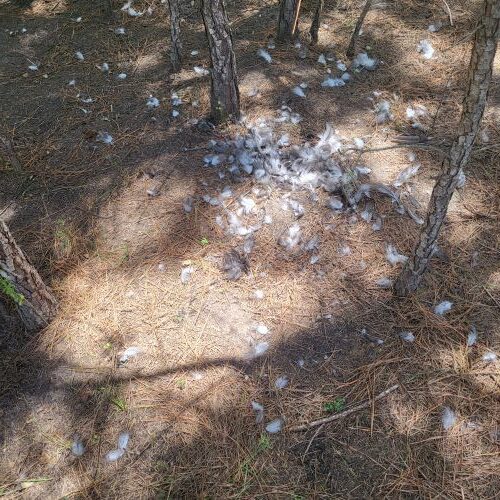
I did not include the image here, but hawks generally can not lift full-grown chickens after the kill and will eat the heads first. If you see a carcass like this, it is almost always aerial (hawk, owl, etc)
